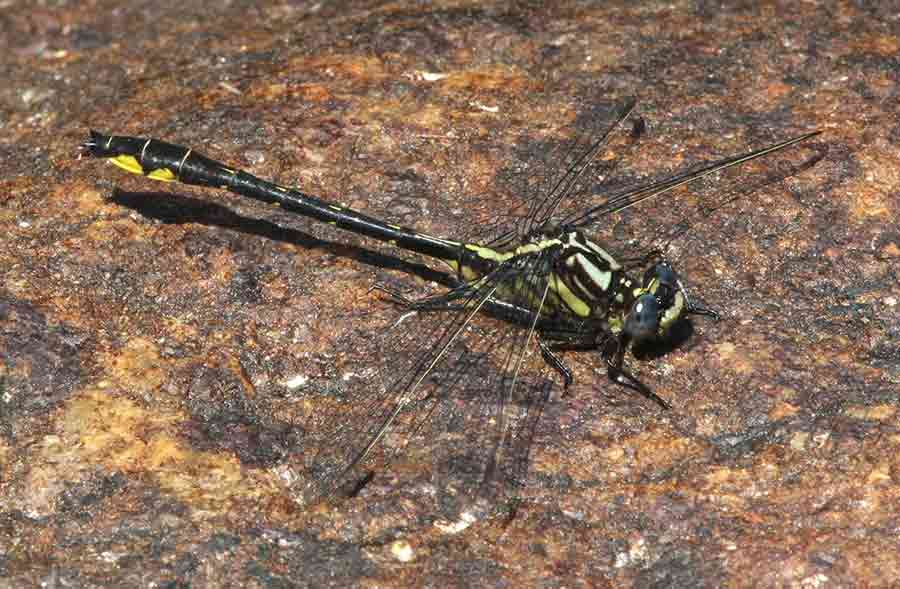Rapids Clubtail

Introduction
This chapter provides a review of progress toward protection and recovery of Rapids Clubtail in Ontario from 2007 to 2015.
Species information
Rapids Clubtail (Gomphus quadricolor) is a small, brightly coloured dragonfly that grows between 42 and 45 millimetres in length with a wingspan of 25 to 27 millimetres. Rapids Clubtail has a yellowish-green face with bluish-green eyes that are set wide apart. The species has dark and light coloured stripes on its thorax and black legs. The species’ abdomen is slender, except for males which have a slightly wider section at the tip.
In Ontario, the species has been known to occur within six rivers: the Credit River near Erindale, the Grand River near Brantford, the Nith River near Paris, the Thames River near Putnam, the Humber River near Kleinburg, and at three locations on the Mississippi River. Rapids Clubtail requires the clear, cool waters of medium to large, swiftly-flowing rivers with shallow gravel-based riffle/rapids areas, projecting rocks, muddy pools and wooded shorelines. Adult males use the rocks as perches; adult females travel from adjacent woods to the rapids where mating takes place.
Rapids Clubtail faces several threats to its survival and recovery. The most significant are activities that result in substantial alteration of its aquatic habitat (such as fluctuating water flows and levels and increased pollution) and terrestrial habitat (such as significant reduction or clearing of forests and treed swamps). Introduction of exotic species, e.g., predatory fish, and climate change are also threats.
The survival and recovery of Rapids Clubtail are influenced by other factors as well. This dragonfly species does not travel far from the occupied (where the species is found) river segment or the adjacent shoreline forest, and it is unlikely to inhabit new areas. The few populations that exist in Ontario are dispersed across the southern region of the province, found in either the southeast or southwest, and appear to be relatively small in size. Small populations with limited distribution are particularly vulnerable as a single disturbance could impact an entire population. Small, fragmented populations can also lead to decreased genetic variation in each population meaning that the species is less able to adapt to change.
Rapids Clubtail is listed as endangered at both the provincial (Species at Risk in Ontario List) and federal (Schedule 1 under the Species at Risk Act) levels. Globally, it is considered to be secure to vulnerable.
Provincial status
The Committee on the Status of Species at Risk in Ontario (COSSARO) assessed Rapids Clubtail as endangered. Following this assessment, it was added to the Species at Risk in Ontario List in 2009. In future assessments, COSSARO may consider information gained through protection and recovery actions regarding the species’ threats and trends in population and distribution.
Species and habitat protection
Protecting Rapids Clubtail and its habitat are key components in the implementation of the Endangered Species Act, 2007 (ESA), and continue to be government-led actions, as identified in the government response statement. As an endangered species, Rapids Clubtail has been protected from being killed, harmed, harassed, captured or taken under theESA since it was listed in 2009. In addition, the species’ habitat has been protected from being damaged or destroyed since 2009. Habitat protection was initially based on the general habitat definition in the ESA. The habitat of Rapids Clubtail is now protected through a habitat regulation that came into force in 2012.
The government developed the habitat regulation (Ontario Regulation 242/08, section 29.0.1) for Rapids Clubtail. The habitat regulation provides clarity to the public and others on what areas are protected as Rapids Clubtail habitat. The regulated habitat includes areas that are required by the species to carry out its life processes (e.g., egg laying, larval development and foraging) within its range in Ontario. The habitat regulation was developed based on information regarding the habitat needs of the species as well as social and economic factors, collected from a variety of sources including comments received through public consultation.
Any person who negatively impacts Rapids Clubtail or its habitat without prior authorization may be prosecuted under the ESA.
Rapids Clubtail has been protected from being killed, harmed, harassed, captured or taken since 2009.
In addition, the habitat of Rapids Clubtail has been protected from being damaged or destroyed since 2009. Habitat protection was initially based on the general habitat definition in the ESA. The habitat of Rapids Clubtail is now protected through a habitat regulation that came into force in 2012.
Recovery strategy
A recovery strategy for Rapids Clubtail was published on September 10, 2010, which was within the timeframe required by the ESA. Recovery strategies are advice to government and represent the best available scientific knowledge. The strategy identifies Rapids Clubtail habitat needs and the threats that it faces, while recommending objectives and approaches for protecting and recovering the species. The recovery strategy also includes recommendations on the areas of habitat to be considered in the development of a habitat regulation.
Government response statement
The Ministry of Natural Resources and Forestry (“the Ministry”) published the government response statement (GRS) for Rapids Clubtail on June 15, 2011, which was within the timeframe required by the ESA. The GRS is government policy that contains the Government of Ontario’s goal for the recovery of Rapids Clubtail.
To help achieve this goal, the government leads and supports recovery actions identified in the GRS. Common actions for the government to lead as it works toward achieving a species’ recovery goal are provided in section 2.5 of the Species at Risk Program Status (2008–2015). One specific action for the government to lead to help protect and recover Rapids Clubtail is:
- Develop a survey protocol to be used by proponents and partners to detect the presence or absence of Rapids Clubtail.
The GRS for Rapids Clubtail also lists eight actions the Ministry supports others to undertake for the species. These government-supported actions fall under the objectives identified in the GRS, which are:
- Protect, maintain and rehabilitate habitat in the three rivers in Ontario where Rapids Clubtail has been found within the past 25 years;
- Conduct an inventory of Rapids Clubtail in suitable habitat; and
- Implement a monitoring program for the locations where Rapids Clubtail is known to exist.
Recovery Goal
The government’s goal for the recovery of Rapids Clubtail is to ensure its long-term survival by protecting existing populations and, where feasible, by rehabilitating degraded habitat at known sites.through the general habitat definition under the ESA in 2009 and then a habitat regulation in 2012
Government funded projects
An important government-led action in the GRS for Rapids Clubtail is to support partners to undertake activities to protect and recover the species. Through the Species at Risk Stewardship Fund the Ministry has supported two projects ($122,450) designed to contribute to the protection and recovery of Rapids Clubtail. Both of these projects targeted multiple species at risk, including Rapids Clubtail, and partners reported that they were successful in securing support ($292,980) from other sources. This amount includes additional funding and in-kind support in the form of time and expertise provided by volunteers.
Stewardship partners also reported that provincial funding helped them to secure in-kind support by involving 167 individuals who volunteered 2,502 hours of their time toward protection and recovery activities for multiple species at risk, including Rapids Clubtail, which has an estimated value of $120,000. Stewardship partners also reported that, through their efforts, outreach about multiple species at risk, including Rapids Clubtail, was delivered to 1,000 individuals.
The remainder of this section highlights one project supported through the Species at Risk Stewardship Fund and the corresponding government-supported recovery actions.
The project contributed toward two GRS actions for Rapids Clubtail by: integrating searches into ongoing benthic (i.e., river bottom) monitoring programs across the province; and training volunteers, such as field naturalist clubs, on undertaking surveys to increase knowledge of its distribution. The benthic monitoring conducted during the project did not result in any observations of Rapids Clubtail, but the monitoring is being continued by the stewardship partner in rivers and streams across eastern Ontario. In addition, training was delivered to members of project partner organizations to enable more effective monitoring, resulting in increased knowledge of the species’ distribution. Information and resources were also provided to landowners and environmental stakeholders about the importance of species at risk, including Rapids Clubtail, and where they occur in the province.
Species at Risk Stewardship Fund
-
 $0
$0for Rapids Clubtail exclusively
-
 $122,450
$122,450for multi-species projects that included Rapids Clubtail
-
 $292,980
$292,980in additional funding and in-kind support
-
 2
2projects included the Rapids Clubtail
-
 167
167volunteers
-
 2,502
2,502volunteer hours
-
 1,000
1,000people received outreach
Efforts to minimize adverse effects on Rapids Clubtail
Supporting partners through permits and their associated conditions is an important government-led action. Three permits have been issued for Rapids Clubtail since the species has been protected under the ESA, all of which have been ‘protection and recovery permits’ (i.e., 17(2)(b) permit). ‘Protection and recovery permits’ are issued if the purpose of the activity is to assist the protection or recovery of a species at risk.
One permit was issued to gather species at risk information to improve management and planning on federal lands in order to protect species at risk, including Rapids Clubtail. The second permit was required to conduct surveys at a proposed waterpower development site, in order to determine presence and absence. The third permit was issued in conjunction with a stewardship project referenced above to search for Rapids Clubtail in ongoing benthic inventory programs as identified as a priority in the GRS.
In order to minimize adverse effects while surveying for Rapids Clubtail, all persons received training in appropriate methods and techniques prior to carrying out the work. In addition, if a species at risk was found during surveying, it was promptly released at the point of capture.
No activities that pertain to Rapids Clubtail have been registered for the purposes of Ontario Regulation 242/08 under the ESA since the registry was established in 2013.
3 protection or recovery permits
Occurrences of Rapids Clubtail in Ontario
Natural Heritage Information Centre (NHIC)
Rapids Clubtail is known to occur in eight populations
Since 2008, the Ministry has received approximately 24 records of the species. These records are based on observations between 2008 and 2015 and come from a variety of sources. Records submitted have helped to redefine where the species is known and has been known to occur and have provided additional information on the species’ habitat and threats. The recent observations noted above confirm that the insect is persisting in Ontario, and have enabled the occurrence status for the Humber River and Mississippi (Blakeney) populations to be updated from historical to extant.
Everyone is encouraged, or may be required by an authorization or approval, to submit observations of the Rapids Clubtail as well as every other species at risk, to the Ministry’s Natural Heritage Information Centre for incorporation into the provincial record of observations.
24 observations of the species were submitted to the NHIC since 2008
Summary of progress toward meeting the recovery goal
Summary of progress
Progress has been made toward the majority of government-led actions and two government supported actions outlined in the GRS for Rapids Clubtail. The Government of Ontario has directly undertaken actions to:
- Encourage submission of Rapids Clubtail data to the Natural Heritage Information Centre;
- Protect the species through the ESA and its habitat through a habitat regulation;
- Support partners to undertake activities to protect and recover the species;
- Establish and communicate annual priority actions for support;
- Educate other agencies and planning authorities on the requirement to consider the protection of the species and its habitat; and
- Undertake communications and outreach to increase public awareness of species at risk in Ontario.
Government-supported actions are organized under over-arching recovery objectives. Progress has been made toward one of the government-supported recovery objectives and two of the associated actions that are identified in the GRS for Rapids Clubtail.
Under the objective to conduct an inventory of Rapids Clubtail in suitable habitat, progress has been made toward one action and initial progress toward a second action:
- Integrate searches for Rapids Clubtail into ongoing benthic inventory programs in rivers across the province (these programs involve collecting benthic macro-invertebrates, which are mostly aquatic insects or the aquatic stage of an insect, that live at the bottom of a water body). As these types of species are sensitive to changes in environmental conditions, they provide valuable information on water and habitat quality;(Action No. 4); and
- Train volunteers, such as field naturalist clubs, on undertaking surveys to increase knowledge of the species distribution (Action No. 5).
These actions have been implemented through a project supported by the Species at Risk Stewardship Fund and through conditions of authorizations.
The recovery goal for Rapids Clubtail is to ensure its long-term survival by protecting existing populations and, where feasible, by rehabilitating degraded habitat at known sites. Effort made toward the government-led and government-supported GRS actions has helped to make progress toward this goal. Three new populations of Rapids Clubtail have been reported: on the Mississippi River (near Almonte), on the Grand River and on the Nith River. Additionally, observations of the species have been made at two previously-known populations since 2008. Overall, through observations since 2008, we are aware of more populations, a broader provincial distribution and overall improved population viability for Rapids Clubtail in Ontario.
Recommendations
As stated in the GRS, the review of progress toward protecting and recovering Rapids Clubtail can be used to help identify whether adjustments are needed to achieve the protection and recovery of the species. Based on progress to-date, the overall direction provided in the GRS for Rapids Clubtail should continue to guide protection and recovery actions for the species, particularly actions identified in the GRS as high priority. Relative to actions that have received a high level of support, the following actions have received support to a lesser degree and may be considered in future decisions regarding the protection and recovery of the species:
- Actions for which progress has been limited should be supported in future implementation planning, such as: developing best management practices for protecting Rapids Clubtail and its habitat and promoting these practices to landowners and land managers whose lands surround occupied locations (Action No. 1; High Priority); and developing and conducting an inventory program for Rapids Clubtail prioritized by historic locations, other sites on the currently occupied rivers and other suitable rivers (Action No. 3; High Priority).
- The action to train volunteers, such as field naturalist clubs, on undertaking surveys to increase knowledge of the species distribution should be further supported (Action No. 5). Continued support of this action will ensure that the first aspect of the GRS recovery goal for Rapids Clubtail is addressed, which is to ensure its long-term survival by protecting existing populations.
- Efforts should be made to rehabilitate degraded habitat at occupied locations, where feasible (Action No. 2). Since Rapids Clubtail is small and inconspicuous, relatively few people can properly identify where this species occurs. Developing and implementing a monitoring program conducted by qualified personnel at known locations (Action No. 6) would support habitat rehabilitation efforts. In addition, researchers should investigate the sensitivity of Rapids Clubtail to various habitat features to determine why the species occurs in so few rivers and to prioritize threats (Action No. 7). Also, experts should carry out research on basic biology, such as prey, duration of life stages and dispersal after Rapids Clubtail emerges from the water (Action No. 8).
Moving forward, protecting and recovering Rapids Clubtail will continue to be a shared responsibility that will require the involvement of many individuals, organizations and communities. Financial support for the implementation of actions may be available through the Species at Risk Stewardship Fund, the Species at Risk Research Fund for Ontario or the Species at Risk Farm Incentive Program. The Ministry can also advise if any authorizations under the ESA or other legislation may be required to undertake a project. By working together, progress can continue to be made toward protecting and recovering Rapids Clubtail in Ontario.
Summary of progress toward the protection and recovery of Rapids Clubtail (2007–2015)
Provincial status:
- Rapids Clubtail is classified as endangered under the Endangered Species Act, 2007 (ESA). The species has been protected from being killed, harmed, harassed, captured or taken and its habitat has been protected from damage or destruction under the ESA since 2009.
Species-specific documents and guidance published by the government:
- Recovery Strategy for Rapids Clubtail in Ontario (2010)
- Rapids Clubtail: Ontario Government Response Statement (2011)
- Rapids Clubtail Habitat Regulation (Ontario Regulation 242/08; 2012)
Government-supported stewardship projects:
- Through the Species at Risk Stewardship Fund, the Ministry of Natural Resources and Forestry (“the Ministry”) has enabled its stewardship partners to conduct a total of two projects ($122,450) that have supported the protection and recovery of multiple species at risk, including Rapids Clubtail.
- The Ministry’s support helped its stewardship partners to involve 167 individuals who volunteered 2,502 hours of their time toward protection and recovery activities for species at risk, including Rapids Clubtail. The estimated value of these voluntary contributions, as well as additional funding and in-kind support, is $292,980.
- Stewardship partners reported providing outreach on multiple species at risk, including Rapids Clubtail to 1,000 individuals.
Supporting human activities while ensuring appropriate support for species recovery:
- The Ministry has issued three ‘protection and recovery permits’ under clause 17(2)(b) of the ESA .
- There have been no registrations of activities for the purposes of Ontario Regulation 242/08 under the ESA for this species.
Occurrences and distribution:
- Eight populations of Rapids Clubtail have been documented in southern and eastern Ontario. Currently, seven of these populations are extant, whereas the remaining one is considered historical. Since 2008, two previously-known populations have had observations through monitoring efforts. Additionally, three populations of Rapids Clubtail have been newly identified since 2008. In total, recent observations of this rare dragonfly have more than doubled the number of currently-known extant populations in Ontario.
Related Information
- Categorizing and Protecting Habitat under the Endangered Species Act
- Habitat Regulation Summary for Rapids Clubtail
- Natural Heritage Information Centre
- Ontario’s Endangered Species Act
- Ontario’s Endangered Species Act Regulation 242/08
- Ontario Recovery Strategy and Government Response Statement for Rapids Clubtail
- Policy Guidance on Harm and Harass under the Endangered Species Act
- Species at Risk in Ontario List
- Species at Risk Stewardship Fund
References
COSEWIC. 2008. COSEWIC assessment and status report on the Rapids Clubtail Gomphus quadricolor in Canada. Committee on the Status of Endangered Wildlife in Canada. Ottawa. vi + 35 pp.
Footnotes
- footnote[1] Back to paragraph A population is defined as an area of land and/or water on/in which an element (i.e., Rapids Clubtail) is or was present. They are comprised of one or more observations and the area has a practical conservation value as it is important to the conservation of the species. An element occurrence is the technical term used to describe this.
- footnote[2] Back to paragraph A population is considered historical if it has not been recorded within the last 20 years. Historical populations may still exist, but updated information is not available.